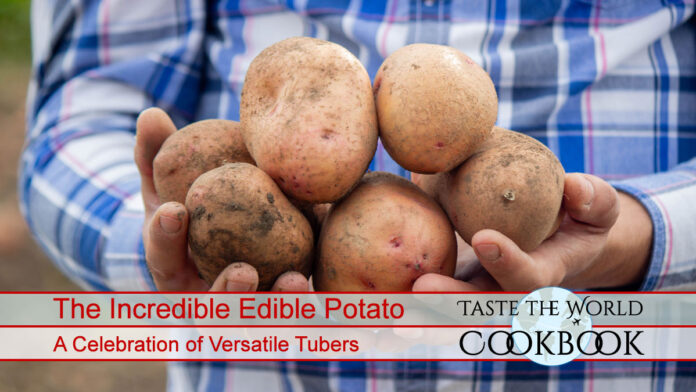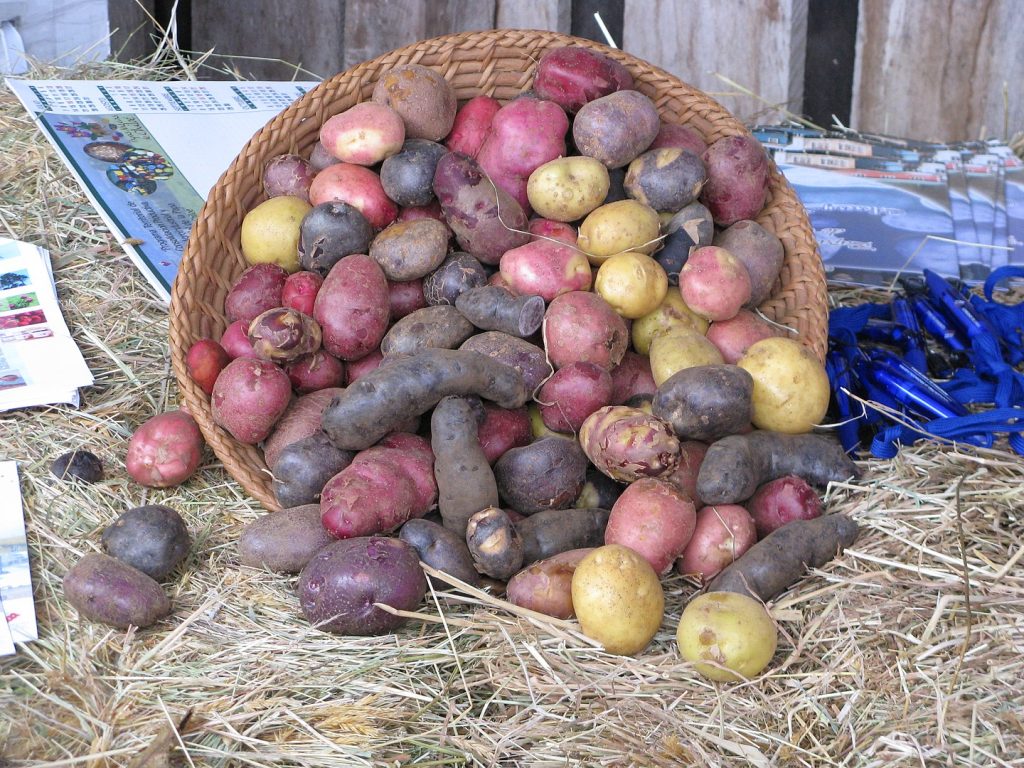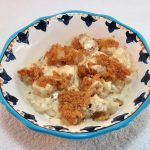The Incredible Edible Potato is a budget-friendly, nutritious, and just plain delicious food staple. The potato is a starchy tuber of the plant Solanum tuberosum. It’s a root vegetable originating in modern-day Peru, can be found wild throughout the Americas, from Canada to southern Chile.
Although one might think of Ireland when talking potatoes, they were domesticated approximately 7,000–10,000 years ago in the Americas. The Spanish introduced the potato to Europe from the Americas in the second half of the 16th century.
Today potatoes are a staple food in many parts of the world and an integral part of much of the world’s food supply. As of 2014, potatoes were the world’s fourth-largest food crop after maize (corn), wheat, and rice.
Top 5 Types of Potatoes
There are close to 4,000 varieties of potato in the world. Each has specific agricultural or culinary attributes. For culinary purposes, varieties are often differentiated by their waxiness: floury or mealy baking potatoes have more starch (20–22%) than waxy boiling potatoes (16–18%).
The Russet Potato
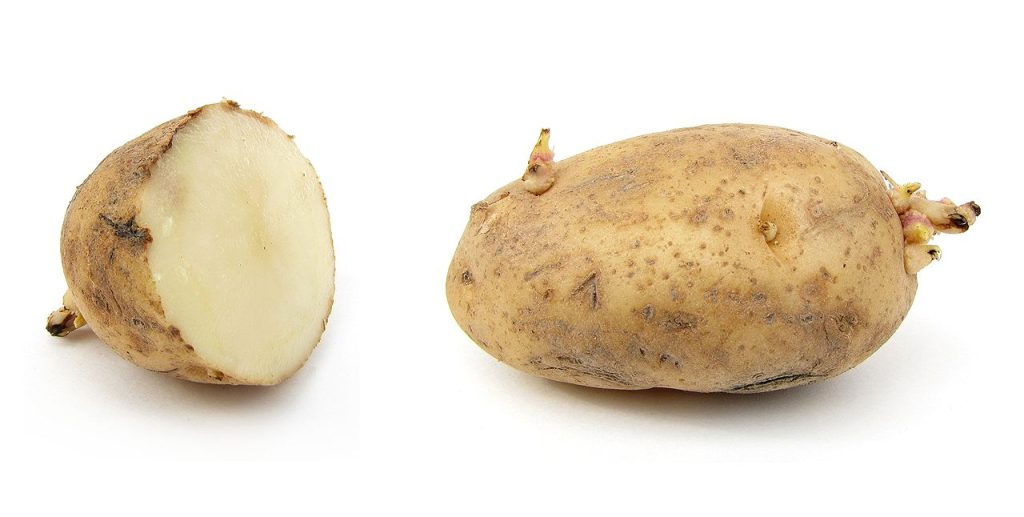
The Russet or Idaho potatoes have the kind of starch that breaks down during cooking and gives you a fluffy mash. It’s large, with dark brown skin and few eyes. The flesh is white, dry, and mealy, and it is suitable for baking and french fries.
The Yukon Gold
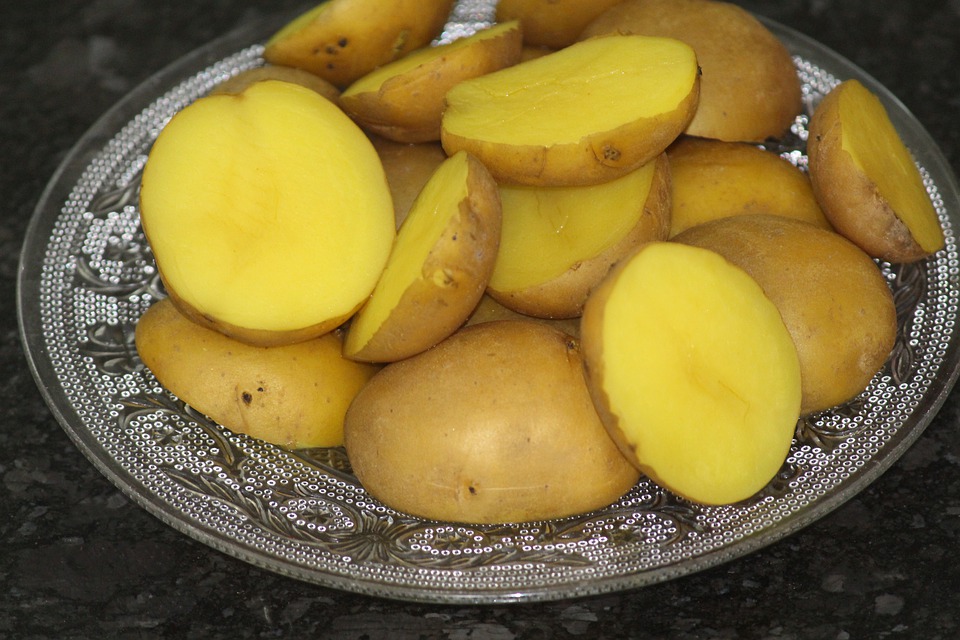
The Yukon Gold Potatoes are ideal for potato casseroles such as scalloped potatoes and potatoes au gratin because they hold their shape well even when thinly sliced. The potato is thin, smooth, eye-free skin and yellow-tinged flesh.
The Red Potato
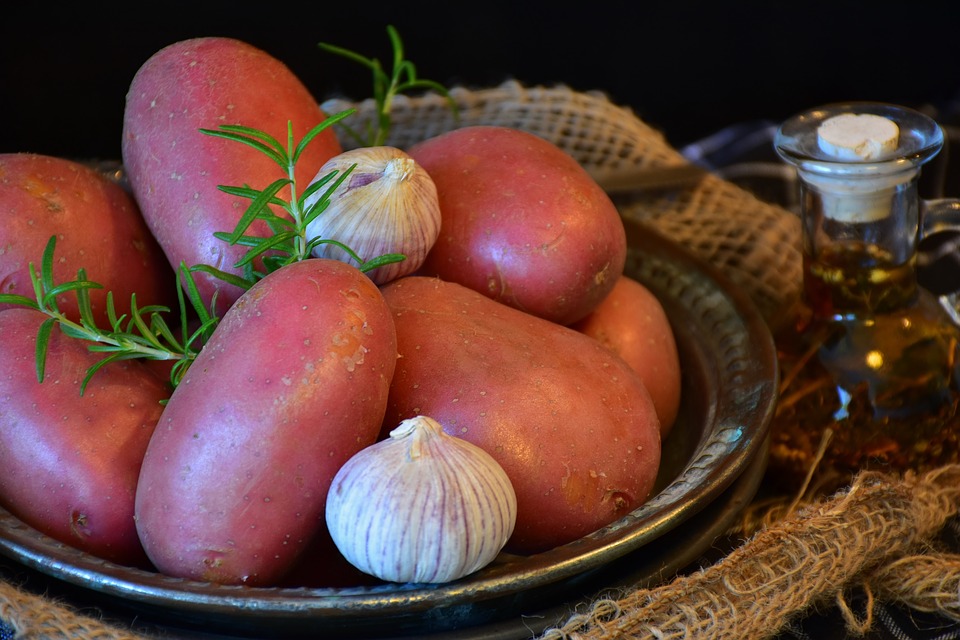
Red-Skinned Boiling Potatoes are waxy and give you a very smooth and creamy mash. waxy enough to hold their shape and starchy enough to soak up flavors. It can be used in recipes for baking, boiling, mashing, roasting, or in salads, and can be cooked in a microwave oven. It is not so suitable for frying.
The White Potato
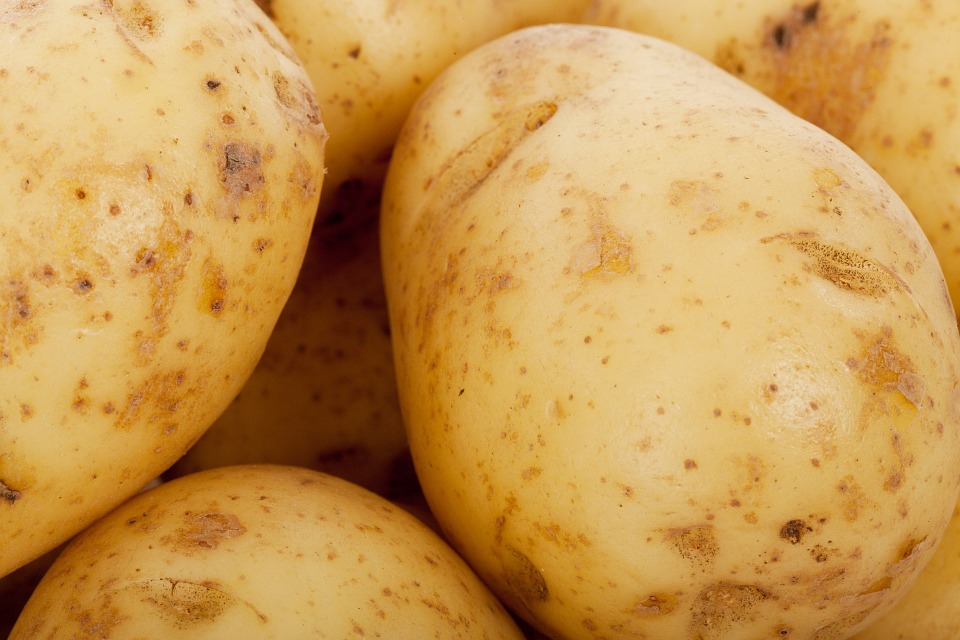
White Potatoes have a medium level of starch and are used for boiling, frying, and microwaving. Compared to Russets, white potatoes have a smoother, thinner, lighter-colored skin. The skins are so thin that they add a slightly pleasant texture to creamy mashed potatoes and yet hold their shape when boiled.
The Purple Potato
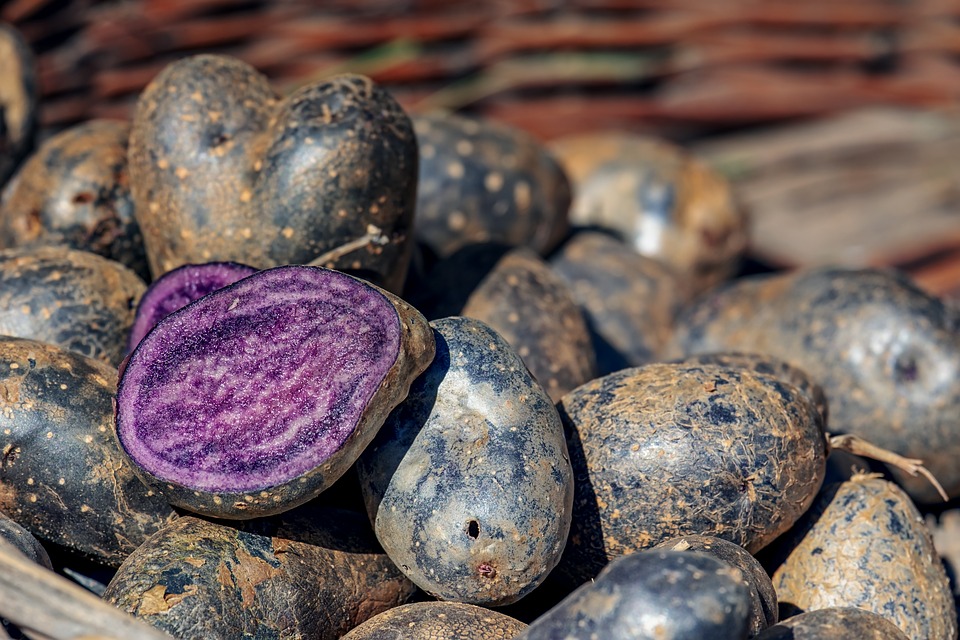
Purple potatoes are the eye-catching gems of the potato aisle. Like other members of the potato family (Solanum tuberosum), they come from a tuber plant native to the Andes mountain region in South America.
While they are purple in color they just taste like regular potatoes. … Besides their striking color, these purple potatoes may even have some health benefits that other potatoes do not have.
Top 5 Recipes
Potatoes are prepared in many ways: skin-on or peeled, whole or cut up, with seasonings or without. The only requirement involves cooking to swell the starch granules. Most potato dishes are served hot but some are first cooked, then served cold, notably potato salad and potato chips (crisps).
Although there are more recipes for potatoes than we can cover here are our recommendations for the top 5 potato recipe categories.
Mashed Potatoes
Different potato varieties mash differently. Russet or Idaho potatoes have the kind of starch that breaks down during cooking and gives you a fluffy mash, while red potatoes are waxy and give you a very smooth and creamy mash. For a happy medium between the two, try Yukon Gold potatoes.
Cooking Tips:
- Scrub, peel, and cube potatoes into 1½-inch chunks.
- Put the potatoes into a large pot, and add enough cold water to cover them by about an inch of water. Choose a large enough pot to allow the water to bubble up but not boil over.
- Salt the water to flavor the potatoes. Some cooks also like to add a bay leaf or a couple of peeled garlic cloves.
- Simmer until fork-tender. Remove a piece of potato and mash it with a fork; it should be cooked all the way through.
- Drain potatoes in a colander (remove the optional bay leaf), then return potatoes to the hot pot (with the heat turned off) so the residual heat cooks off extra water. No more watery mashed potatoes!
- Don’t overwork the potatoes when you’re mashing them. This breaks down the cell structure and turns them gluey and flat.
- For fluffier, lump-free mashed potatoes, you can push them through a potato ricer or food mill. Otherwise, just mash them in the pot with a simple potato masher for a more rustic texture.
- Add slices of softened butter and mash into the potatoes. After the first mash, pour heated milk into the potatoes and mash again make them creamy. You can also add sour cream for a little more richness and tang. Adjust the seasonings, spoon into a warmed serving bowl, garnish with parsley, and serve.
Baked Potatoes
Starchy Russet or Idaho potatoes make the best baked potatoes. With thick, sturdy skins, they are better able to hold all the toppings and extras you can stuff them with. Twice-baked potatoes take it a couple of steps further: You scoop out a baked potato, mix the cooked potato with any number of creamy, savory add-ins, spoon it all back into the potato skins, and bake again.
Cooking Tips:
- Scrub the potato skins but do not peel.
- Pierce the potato skin with a fork or paring knife to let steam escape.
- Foil or no foil? Potatoes wrapped in foil hold in steam, making the skins more tender. For crispier skins, skip the foil.
- Oil or no oil? Rubbing a little olive oil on the potato skin softens it slightly as it bakes. You can also skip the oil if you like. Your potato; your rules.
- Set the potatoes in the oven right on the rack or on a sheet pan. Bake at high heat (400 to 450 degrees F (200 to 230 degrees C).
- Set out butter, sour cream, cheese, snipped herbs, chili, etc., and let everyone customize their own loaded baked potatoes.
Potato Casseroles
We like the Yukon Gold for potato casseroles such as scalloped potatoes and potatoes au gratin because they hold their shape well even when thinly sliced.
Cooking Tips:
- Use a mandoline or sharp chef’s knife to make thin, even slices.
- Layer the slices evenly in the baking dish, and season between layers.
- If you cover your casserole with foil before baking, cut a few slits in the top to let steam escape.
- After you take the casserole out of the oven, let it sit for about 10 minutes before serving.
Roasted Potatoes
Any potato is a good candidate for roasting, but the best potatoes are varieties such as Yukon Gold and red-skinned boiling potatoes. They’re waxy enough to hold their shape and starchy enough to soak up flavors.
Cooking Tips:
- Scrub the skins and leave them on.
- Cut in uniform pieces so they cook evenly.
- Dry them thoroughly on paper towels before coating and roasting.
- Lining your sheet pan with foil instead of parchment paper leads to better browning.
- Don’t crowd the sheet pan if you want crispy skin. Crowding causes steaming instead of roasting.
- After drizzling potatoes with oil and seasonings, get your hands in there and toss the potatoes to coat them evenly.
- Roast on high heat — at least 425 degrees F (220 degrees C).
- Flip potatoes with a spatula a couple of times during the roasting so all sides get evenly browned.
Potato Salad
The potatoes you use for potato salad depend on your personal preference. A starchy Russet potato breaks down as it cooks, resulting in a creamier consistency, while an all-purpose Yukon Gold or waxy red potato holds its shape and gives you a firm but tender texture.
Cooking Tips:
- If you’re using a waxy potato, you can leave the skins on. (Do note that red potato skins can sometimes be a little bitter.)
- Cut potatoes into uniform pieces.
- Start potatoes in cold, salted water and bring them to a boil. Simmer until fork tender.
- While potatoes are cooking, you can prepare the dressing in a separate bowl so you don’t overwork the potatoes when you toss them with the dressing.
- For the best flavor, make potato salad the day before and let it chill. It always tastes better the next day.
